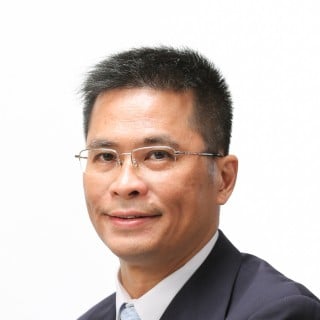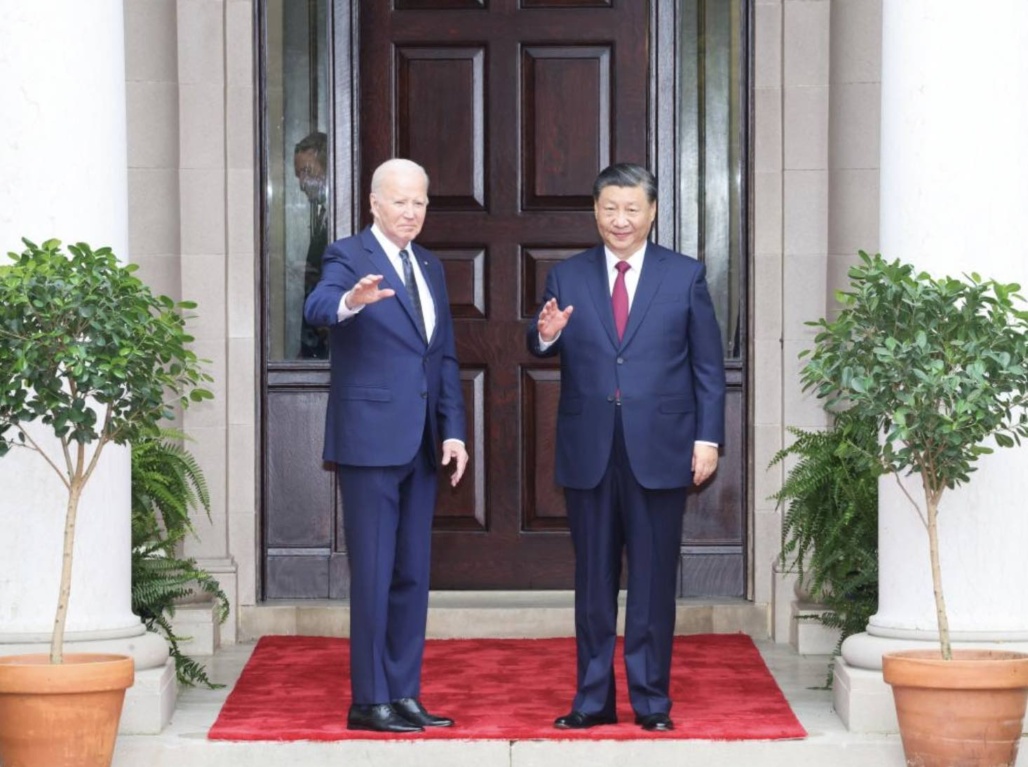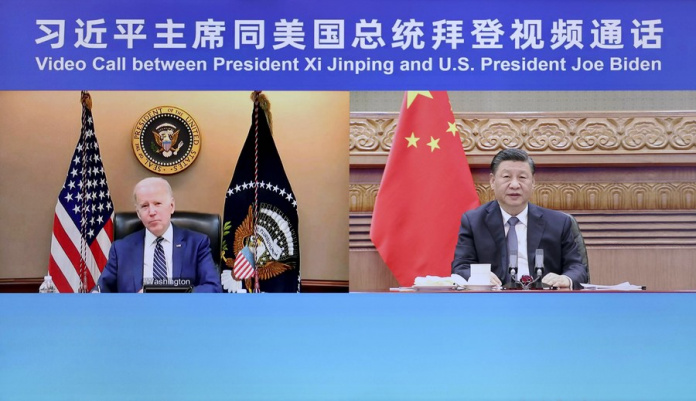The presidential diplomacy of reengaging the other side and repositioning their stance was a hallmark of Xi Jinping’s 2-hour phone discussions with Joe Biden on April 2 amid ongoing Sino-US tensions over economic, political, and military affairs. Such reengagement and repositioning remain the enduring characteristics of Sino-US relations since the San Francisco meeting in last November 2023.

Unlike the Donald Trump administration which engaged in a fierce ideological and trade war with China, the Joe Biden government has since January 2021 attempted to look for opportunities of reengaging the People’ Republic of China (PRC). The most recent telephone dialogue between President Joe Biden and President Xi Jinping took place at a politically significant period during which the upcoming US presidential election will be held seven months later. Furthermore, the “presidential” inauguration of the new Taiwan leader, William Lai Ching-te, will be held on May 20. While the PRC government will be expected to react to what Lai will say in his inaugural speech, the Biden administration made its position clear on the telephone dialogue with the Xi Jinping side on a whole range of issues.
According to news report, the US maintains its “one-China policy,” does not support “Taiwan independence,” does not seek “the new Cold War,” does not intend to change the Chinese system, does not seek to oppose China through the consolidation of its alliances, does not intend to have conflicts with China, does not seek to curb China’s development, and does not seek to decouple or delink with China – a posture with one certainty and seven “NOs.”
President Xi Jinping reiterated three positions from the Chinese side, namely seeing a peaceful stance as valuable, seeing stability as of utmost importance, and seeing trust as the foundation of Sino-US relations. In terms of peace, the Chinese side maintains the principle of no conflict, no confrontation as the bottom line, and persistence in elevating the Sino-US relations. Regarding stability, China adopts the position of not disrupting, not provoking, not stepping over the boundary of the other side, thereby maintaining the overall stable relations with the US. In terms of trust-building as the basis, China utilizes actions to realize its promises, turning the visions of the San Francisco into realities.
President Xi Jinping emphasized that the strategic understanding of China and the US is “the first button” that should be fixed by both sides – meaning that Beijing and Washington must avoid confrontation, must have mutual respect, must persist in the stable, healthy, and sustainable path rather than returning to the old road.
Clearly, both sides reiterated their previous stance in a more refreshing and emphatical manner, utilizing the San Francisco consensus as the basis to tackle issues of “low politics,” such as climate change, narcotics control and people-to-people exchange.
The Xi-Biden telephone talks went through the ideological differences of both sides, but indeed without any breakthrough. The Chinese side, as before, emphasized that the red line over Taiwan must not be crossed and that the US has heightened the risks of Sino-US relations by suppressing China’s economic, technological and trade development.
At the same time, the US side stressed the importance of stability and peace across the Taiwan Strait, emphasized the importance of the “freedom of navigation” in South China Sea, expressed its concern about the Chinese support of the Russian military-industrial complex, the “unfair trade policy and non-market economic practices” of China, and indicated that Washington would avoid a scenario in which the US technology would be utilized to “weaken the American national security.” The Biden administration reiterated its stance over the denuclearization of the Korean peninsula, implying perhaps China would be expected to play an active role in reining in the militaristic behaviour of North Korea.
In response to the US concerns, the Chinese side reiterated in the telephone meeting and at the Foreign Ministry’s press briefing afterwards that China has its “indisputable sovereignty” over the related islands and nearby waters in the South China Sea, and that Washington should not intervene in the affairs between Beijing and Manila. China, according to Foreign Ministry spokesperson Wang Wenbin on April 3, is willing to exchange with the US over human rights issues, which however should not be used as an excuse to interfere with the Chinese internal affairs – a position referring to the US side’s concern about “human rights” condition in China and Hong Kong.
In a sense, all the issues discussed above were more about mutual posturing rather than a search for constructive solutions, but clearly the Biden government’s positioning aimed at paving the way for two talks to be followed soon – one on trade and the other on trust-building and dialogue over military issues.
Immediately after their dialogue on April 2, both sides have reengaged each other in two fronts – US Treasury Secretary Janet Yellen’s visit to China and she met Chinese Vice Premier He Lifeng on trade issues, and the meetings in Hawaii of the Sino-US Military Maritime Consultative Agreement Working Group with the US side represented by officers from the Indo-Pacific Command, Pacific Fleet and Pacific Air Forces over issues like airspace and maritime operations.
As expected, Yellen has articulated the US concerns about China’s so-called “industrial overcapacity” with Chinese exports that affect the interests of the American workers and industries. Yellen complained about “unfair industrial practices” in China, telling He Lifeng that China’s state subsidies to its green energy, electric vehicles, and electric batteries were “excessive,” leading to a “flood” of the related Chinese products in the US and world markets where the competitiveness of many industries were “weakened.”
At the same time, the US commerce official Marisa Lago initiated a ministerial-level meeting with the Chinese commerce’s vice-minister Wang Shouwen to discuss tariffs and market access issues. The US is going to use tariffs to protect its industries over the “flood” of Chinese products in its market, but both sides attempt to bargain and extract a satisfactory deal with the other on the negotiating table.
The US concern about China’s “industrial overcapacity” was simultaneously raised by its trade representative Katherine Tai during her trip to Belgium where she told the EU representatives on April 4 that the US and EU should collaborate in resisting the Chinese “overproduction” and “exports” of steel, aluminium, solar panels, and electric vehicles.
Apart from the trade tensions between the US and China, both sides have been engaging each other through face-to-face dialogue over military issues in Honolulu, Hawaii. The military dialogue in Hawaii on April 3 and 4 was politically significant, as Colonel Ian Francis of the Indo-Pacific Command said the US “will continue to operate safely and professionally in the Indo-Pacific whatever international law allows, and we take this responsibility seriously.” He added that “open, direct, and clear communications” with the officers of the People’s Liberation Army (PLA) “is of utmost importance to avoid accidents and miscommunication.” Recently, the US has criticized the Chinese side for “coercive and risky operational behaviour” because the Chinese fighter jets were seen as “discharging chaff and shooting flares” when they approached the American fighter aircraft at high speed.
Objectively speaking, the military dialogue between both sides can minimize differences, enhance mutual understandings, and hopefully will reduce the possibility of unnecessary airspace accidents. China suspended military communications with the US shortly after the provocative visit by former US House Speaker Nancy Pelosi to Taiwan in August 2022. The resumption of formal military dialogue in Hawaii can be seen as an important step in mutual trust-building and their enhanced communications.
Still, militarily speaking, trust-building in Sino-US military relations is by no means an easy task, given the necessity of encountering numerous challenges ahead. The Chinese Foreign Ministry on April 4 appealed to the US military to “terminate” the military exchange, links, and “collusion” with the Taiwan side. It is reported that Taiwan’s naval chief Tang Hua will visit the US from April 8 to April 10 to attend a Sea-Air-Space conference at Washington, and that he will likely meet the US chief of naval operations, Admiral Lisa Franchetti.

Tang’s visit to the US will take place before the Taiwan’s military exercise in April and July. Some Taiwan observers have indicated that Taiwan would not participate formally in the US military exercise in the Pacific, but it will likely join as an observer. Still, such a move would very likely be seen as “provocative” by the mainland Chinese side.
In the past, some senior Taiwanese military officers visited the US to attend defence-related conferences, such as the visit of navy chief Lee Hsi-ming in 2015 and deputy defence minister Hsu Yen-pu in 2023.
This time, according to Reuters, Tang Hua’s visit is expected to fall under the US Joint Island Defence Concept, which refers to the coordination between Washington, Tokyo, and Taipei to counter or resist the PLA within the so-called “first island chain” – a strategic chain of islands connecting Japan, Taiwan, the Philippines, and Borneo. The concept reflects the way in which the US has been adopting military deterrence against the perceived Chinese military expansion and threat in the Pacific Ocean.
Perhaps the Tang visit to the US should not be overstated by the mass media, especially as Kinmen on April 2 suspended a naval military exercise as a goodwill gesture of avoiding any provocation to the mainland Chinese side on the day when Biden engaged his telephone diplomacy with the Chinese president.
Militarily speaking, the US, Japan and the Philippines are planning to enhance their joint military exercises in the Pacific Ocean, while simultaneously building up their internet infrastructure to present any internet attack from China, Russia and North Korea – moves that appear to reflect a hidden new “Cold War” even though the Biden side said in the telephone dialogue with the Chinese side on April 2 that the US does not seek any “new Cold War.”
Furthermore, Kurt Campbell, the US Deputy Secretary of State, said on April 3 in Washington that the AUKUS (Australia-United Kingdom-United States) has a submarine blueprint that can and will help “curb” any moves by mainland China on Taiwan (Oriental Daily, April 5, 2024, p. A14). Given the nature of AUKUS as a trilateral security organization with the aim of promoting peace, security, and defence against perceived threats to the international order and system, Campbell’s remarks were politically and militarily significant.
Recently, the US opposed the moves by China to rename 30 places along the 3,000 km disputed Himalayan border between India and China, or the so-called “Line of Actual Control.” China sees some places in the Indian-administered Arunachal Pradesh state, which Beijing refers to as the Zangnan and part of the Tibet autonomous region, as Chinese territory – a position disputed by the Indian side. After a military skirmish between street-level soldiers from the Indian and Chinese side – an event leading to the deaths of reportedly 20 Indian and four Chinese military officers – the Indian and Chinese militaries held 21 rounds of talks. But recently, the Indian side has appeared to build up its military forces and infrastructure along the border with China, raising the anxieties and prospects of a sudden military conflict. If the US suddenly sides with India over the latter’s border dispute with China, there will be severe limitations in the improvement and reengagement of US-China relations.
All the ongoing moves made by China and the US, and the American allies, have perhaps demonstrated that, after the collapse of the former Soviet Union in 1991, the unipolar world led by the superpower US has increasingly encountered the perception of “the China threat,” which to many countries and their leaders appear to be a real one. As such, the rise of China, especially its economic development, trade expansion and military modernization, has really challenged the unipolar world led and dominated by the US. The trade war between China and the US under the former Donald Trump administration was a testimony to the perceived Chinese economic threat. Although the Joe Biden administration has reengaged China assertively, the trade war persists. Militarily speaking, China is seen as a perceived threat by the US, but the reengagement process has begun in Hawaii when military officers from both sides sat down to enhance their communication and understanding.
In conclusion, the content of the Xi-Biden telephone talks was mostly a reiteration of the well-known positions from both sides, but they paved the way for the ensuing discussions among other officials over trade and military affairs. In a sense, the Xi-Biden telephone diplomacy was not only an attempt at reengagement from both sides, but also a warm-up session leading to in-depth discussions over trade disputes and military-related issues. Hence, even if trust-building needs a persistent and regular telephone diplomacy involving the presidents of both countries, mutual dialogue and communication can and will hopefully minimize misunderstandings. Still, the context of the Xi-Biden talks is challenging, given the ongoing US-China military competition and rivalries. The contextual difficulties have been compounded by how the US deals with China’s neighbours, including not only the contentious issue and future of Taiwan but also their relations with Japan, North Korea, the Philippines, and India. Limitations to a more cordial Sino-US relationship persist, but the San Francisco meeting in November 2023 did play a crucial role in building up an indispensable element of trust between the US and China in their very long, difficult and uncertain path of friendship ahead.
*Sonny Shiu-Hing Lo is a political scientist, veteran commentator, and author of dozens of books and academic articles on Hong Kong, Macau, and Greater China




















